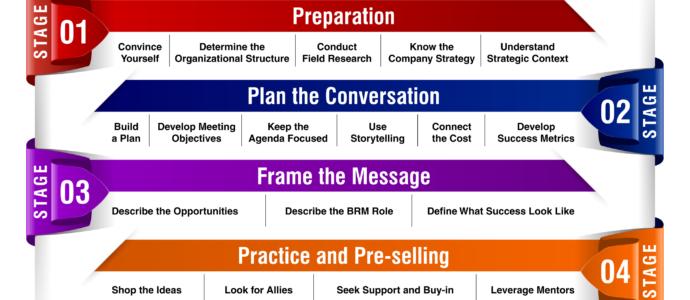BRM Capability
A business relationship management capability is everything it takes, both visible and invisible, to nurture relationships in an organization. Examples of visible components are meetings, artifacts, and professional development, while examples of invisible components are knowledge learned, experience gained, trust, and confidence-building. Used effectively, these components build the endless reserve of energy necessary to evolve culture, build partnerships, drive value, and satisfy purpose.
The business relationship management capability facilitates culture advancement, driving it to one of trust, creativity, innovation, authenticity, and shared ownership across the organization. A mature business relationship management capability converges cross-functional teams to create holistic strategies that deliver organizational value and meaningful results.
Click here to learn more on: BRM Capability Defined | BRM Capability Success
The BRM Role in Financial Planning
When it comes to budgeting, what is the BRM’s role? We discuss the answer to this question and more through the ABCs of Financial Management: Accounting, Budgeting, and Charging.
Getting the Most Value Out of Business-IT Relationships
In today’s times, the nature of the relationship between business and IT can best be described as co-creational. So what do the business and IT need from each other to succeed?
Your Organization Isn’t Unique. Here’s What Is.
Just like animals, there are different “species” of organizations that have evolved, making various adaptations now evident. Learn what exactly sets you apart in your organization.
The Brexit Effect: The Role of the BRM in Uncertain Times
In light of the Brexit decision, many businesses are now dealing with a period of uncertainty both inside and outside of the U.K. What does this mean for BRMs?
The Journey to Build a High Value-Delivering BRM Organization
Whether you’re leading a team or you’re the BRM, it’s important to determine what success looks like and how to get there before embarking on your next BRM journey.
Marketing and IT: Conflict or Collaboration?
In order for IT to become value-adding for Marketing, strengths-based leadership needs to promote collaboration. Once the spirit of collaboration is in place, leadership should then establish a “connector” role. Read on to learn more about how you can play a part in bringing this role to life.
Lean Out Over the Tips: Infiltrating Your Enterprise with Proactive Interaction
Most BRMs are aware that IT’s path to a strong, strategic relationship with business partners starts on a much smaller scale, built on a foundation of trust that’s earned over time by illustrating competency, engagement, desire, and an approach that’s anything but self-serving. However, what you also need to move beyond the realm of IT order-taker—after deciding that you do want something different, of course—is to introduce proactivity into your service model.
The Case for BRM: A Practical Framework for Your CEO Conversation
Getting your company’s BRM capability off the ground takes planning, patience, and perseverance. Successful BRM programs are game-changing for companies that get it right, but planning and preparation are essential to getting your program off to the right start. Here are four concepts to consider when building your plan…
The Case for BRM: Example Scenarios
The following are examples of real-world scenarios that paved the way for the BRM role at three different companies. This is a companion white-paper to The Case for BRM: A Practical Framework for Your CEO Conversation.
Webinar Recordings
An archive of select recorded BRM webinars.
Measuring the Effectiveness of Your BRM Capability…When You Don’t Have a Formal BRM Capability
First Steps for Your BRM Journey
The Business Relationship Management journey from Level One Ad-hoc and Level Two, Order Taker isn’t easy, especially if you’re alone or in a small group and leading the change. Here are some small steps to get you started. We all know change isn’t easy, and even when a situation isn’t satisfying, we’re more comfortable with a […]
The Career Journey from a BA to a BRM
It has been my belief for a long time that the BRM role is one of the most difficult roles to fill in the IT family. It takes a combination of skills that span the curiosity of a good BA, the discipline of a PM, and the courage of a junior high teacher. When you […]
An Unlikely Road: BA to BRM and Why It Makes Sense
Somewhere along the way in my academic journey I read Robert Frost’s “The Road Not Taken,” and I can honestly say it struck me as being so profound. I wasn’t exactly sure why I found it to be enlightening as a young undergrad (maybe because I knew I had to speak to it in class), […]
A BRM Digital Transformation Strategy that Delivers Results Through Business Partnering
When building a digital strategy, common pitfalls are easily overcome by realizing that digital leadership comes from many places inside your organization. Get started with your BRM capability and a cross-organizational Digital Council.
More Than a Fringe Role: Positioning the BRM to Create Organizational and Personal Value
By Sheila Smith and Brian Bell Sheila Smith, President, Omega Point Consulting Brian Bell, Senior Manager, Business Engagement, Church & Dwight More Than a Fringe Role: Positioning the BRM to Create Organizational and Personal Value BRMConnect 2015 Thursday May 28 – 10:45 – 11:30 AM Much of it is actually in our hands! Yes, indeed, […]
Bridging the Chasm: Creating Close-knit IT and C-Suite Relationships
Joe Topinka, award-winning CIO, founder of the CIO Mentor, LLC, published author, and a member of BRM Institute Executive Council recently took the virtual podium to share his thoughts and golden nuggets of professional wisdom with dozens of attendees of the “Bridging the Chasm: Creating Close-knit IT and C-Suite Relationships” BRM Institute webinar. In the […]
Business Relationship Management Lessons from Nature
With spring in full bloom and the summer at our doorsteps, many of us are already exploring the countless treasures of nature. Some of us are heading to the beach, while others are enjoying the pristine beauty of the fields, forests, or mountain ridges. With yet another busy work week behind, many will find a […]













